Battery

We were content for a long time with programing our Midi drums sequencies. We were having in general at disposal some kits in standard GM without any large tones. I would even bet that this conccured to the bad credit of computer assisted music which have been often told to be unexpressive and linear. With the distance, this judgement can be justified ! Those times are completed and our favorite editors propose nowadays some powerful tools to replace acoustic instruments that we don't have of necessity at disposal in our home-studios. Drums are a good example...
It's difficult to talk about Battery without
making a reference to LM4. Indeed, one more time, Native Instruments took
at their account a Steinberg concept but in order to improve it, to go
further and to drive it into a corner
(the story will be effective again with Kontakt and HALion). But we'll
see that these two softwares wouldn't have the same finality.
Battery is thus a virtual instrument dedicated to drums. It is available
in VST, DXi, but also in stand-alone, Sound Manager, MAS and Direct Connect
formats. Battery is released with its package of varied Kits, we'll talk
about this later.
Let's have a look to the summary of the "animal's" specifications
:
- Akaï compatibility, SF2, LM4, AIFF, WAV from 8 to 32 bits
- Internal resolution in 32 bits
- Sample synchronisation
- 54 pads (named cells) per kit
- 128 velocity layers per cell
- An effect section rather furnished
- More if affinities !
I've tested the software in its VST version with Cubase SX 1.05, old habits, you know !
It is done without any grief, only some classics. You are just asked for a folder directory. I suppose that the protection is integrated to the CD itself. In short, any damned process to authorize the soft, that is already a good point.
Arf, Native Instruments' interfaces? It's surely a fancy question, but honestly, I'm hard put to it. Battery's interface is rather dark, with some buttons and a serigraphy which require a visual capacity of 253/10 ! The software offers many processing and effects possibilities, as a result there's an overpopulation regarding the buttons. It is clear, if loading a kit and using it is very simple, the reminder will oblige to go through the "manual" square. The good news is that this one is released in paper format in French? Let's see all of that in detail? Rather than making you a long decription, I will proceed as if you wanted to create a new kit, step by step.
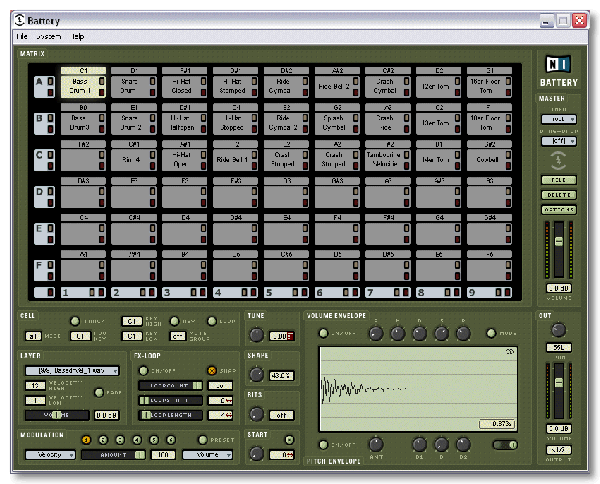
Clic on the picture to have a larger view...
It is divided in three distinct parts :
-
The « Matrix » at the top of the window, it is the whole cells, pads, which will receive the kit samples.
-
The low part is the one which manages all the parameters and effects. It groups the Slot, Layer, FX-Loop, Modulation, Tune and Shape, Envelope and Output sections. Big menu, isn't it ?
-
The Master section on the right side, which, as its name indicates...
 It
is located on the left side of the interface and allows the adjustment
of the global behaviour of the software. There you can find :
It
is located on the left side of the interface and allows the adjustment
of the global behaviour of the software. There you can find :
-
Info Menu : specifies which info will be displayed into the cells. The choice is wide but the much judicious is the option « Follow » which will make displayed the parameter being edited. Well done !
- Drag?n?Drop : Which parameters will be concerned by an Audio file import via Drag?n?Drop into a cell ?
- File : from this option you will be able to import some files or some kits or more to save the kit in progress. It proposes also some very useful functions like replacing a file by an other one, adding a new layer. Note : the LM4 import is limited to the kits foregone for the first version of LM4 (presented as a script in a text file)
-
Delete : as its name indicates, it allows to do some cleaning ! You can delete on your choice, one or several layers, or a cell
- Options : some basic but important adjustments are proposed here, like the Audio outputs number (8 stereo and 16 mono !), the systematic conversion of the files to 32 bits, the type of response to velocity, the Midi controllers mapping etc...
-
Volume : I dare not tell you what it is useful for !
Nothing to add here, each parameter has its evident usefulness and anything's missing.
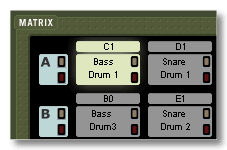 Big
chapter ! Native named this Battery's section « Matrix »,
it is perfectly suitable. Cells could be equivalent to the pads that you can find on hardware groove boxes, but much more evoluted.
Big
chapter ! Native named this Battery's section « Matrix »,
it is perfectly suitable. Cells could be equivalent to the pads that you can find on hardware groove boxes, but much more evoluted.
Indeed, each cell can receive up to 128 samples, nothing less ! The minimum is to indicate then the Midi note or notes which will release the sound. We'll see later all the outrages that you can apply to a sample or a cell.
A cell gives two informations :
- Its name
-
A parameter value, depending of the adjustment done in the Master section.
To build a kit, the way to follow is rather simple : you import some audio files in the cell, from the File menu or by drag'n'drop. The contents of a cell can
be moved or copied to an other cell.
Any possible critical on the subjet, it is convenient and simple.
Right here, all is OK, Battery is a sample reader like any other one else. Let's see now what is its particularity : the edit, in short, the thrashing !
The low part of the interface groups the whole adjustments, processing and effects. The values can be modified by clicking on them and by moving the mouse vertically. Confusing at the beginning, you get accustomed very well with this. It is however possible to enter manually a value with the keyboard by doing a Control/Click.
- Cell :
 Here, you will adjust the vital minimum, receiption Midi channel, the Midi notes band, and the Mute group. This is not all, you have also at your disposal some functions like Reverse, Loop, and Keytrack which allows to assign a sound to a notes band and to make the sound height varying depending of the played note. Those parameters are applied to the entire cell and not to a particular sample of this cell.
Here, you will adjust the vital minimum, receiption Midi channel, the Midi notes band, and the Mute group. This is not all, you have also at your disposal some functions like Reverse, Loop, and Keytrack which allows to assign a sound to a notes band and to make the sound height varying depending of the played note. Those parameters are applied to the entire cell and not to a particular sample of this cell.
-
Layer :
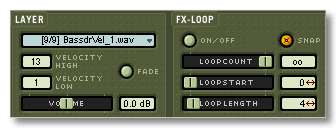 here
you can work sample by sample. You will choose first the file you work on by a pop-up menu.
I'd rather like as in LM4 a little box which let appearing all the cell contents, but well...
You've got in this section the response band to velocity, the volume, a possibility of crossfade between
two sounds sharing a same velocity band. Excellent !
here
you can work sample by sample. You will choose first the file you work on by a pop-up menu.
I'd rather like as in LM4 a little box which let appearing all the cell contents, but well...
You've got in this section the response band to velocity, the volume, a possibility of crossfade between
two sounds sharing a same velocity band. Excellent !
-
FX-Loop :
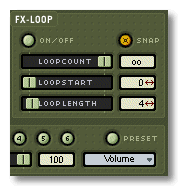 you
understood, you can loop a sample by choosing the point departure, the length and the repetitions number. If you
followed all, you can notice that it is thus possible to
loop, not a cell, but a sample in a cell. I let you imagine all effects you can create from this principle !
you
understood, you can loop a sample by choosing the point departure, the length and the repetitions number. If you
followed all, you can notice that it is thus possible to
loop, not a cell, but a sample in a cell. I let you imagine all effects you can create from this principle !
-
Modulation :
 you
arrive here in an other dimension if you consider that you have under the mouse at the starting
a software dedicated to drums. The more it has, the less it can do, Battery has at disposal 6 (six !) modulations ! The principal
is simple but dreadful. You choose a modulation source (a
Midi controller, the velocity, the pitch-bend, the aftertouch, etc.) and
a target (volume, pan, the envelopes, the bits number, the pitch,
the loop parameters etc?). Here again, the caused damages
can be terrible ! A nice idea again : the modulation adjustments
can be saved as presets.
you
arrive here in an other dimension if you consider that you have under the mouse at the starting
a software dedicated to drums. The more it has, the less it can do, Battery has at disposal 6 (six !) modulations ! The principal
is simple but dreadful. You choose a modulation source (a
Midi controller, the velocity, the pitch-bend, the aftertouch, etc.) and
a target (volume, pan, the envelopes, the bits number, the pitch,
the loop parameters etc?). Here again, the caused damages
can be terrible ! A nice idea again : the modulation adjustments
can be saved as presets.
- Tune :
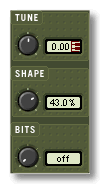 a series of parameters again which can be applied to a whole cell, the chord, the compression / expansion, the number of given back bits and the offset of the playback starting point.
a series of parameters again which can be applied to a whole cell, the chord, the compression / expansion, the number of given back bits and the offset of the playback starting point.
- Envelopes :
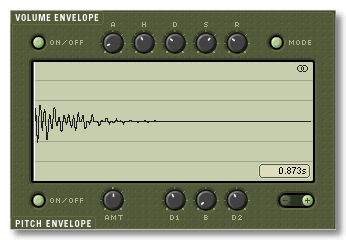 two
ADSR envelopes are proposed, one controls the volume, the other one the pitch. Only some classical, but made of efficiency !
two
ADSR envelopes are proposed, one controls the volume, the other one the pitch. Only some classical, but made of efficiency !
- Output :
 final touch, volume, pan and Audio output. The 8 stereo outputs and the 16 mono outputs are undeniably one of the fortes of Battery. Being able to send the different elements of a kit to some distincted outputs will let as much fringe when mixing for applying to them effects and eq separately.
final touch, volume, pan and Audio output. The 8 stereo outputs and the 16 mono outputs are undeniably one of the fortes of Battery. Being able to send the different elements of a kit to some distincted outputs will let as much fringe when mixing for applying to them effects and eq separately.
To resume, an evidence is imposing itself : Battery is much more than a simple drums sample reader, it is also a powerful tool for creating some original sounds.
20 kits are released on the installation CD. Her, besides, those same 20 kits are also present on the second CD, of which I didn't understand the service. Maybe I missed a step, but the manual is still silent on the subject?
There are some for every likes, you just need to read the kits names : 70's Reggae samples, Drum'n'Bass samples, REAKTOR samples, Hip Hop samples, 60's Garrage samples, Rock samples, it goes from basic to the very uncommon one. Nevertheless, I think that the acoustic kits are less good than those released with LM4 and Wizoo signed, a reference on the subject. It's even so a pity having a software with so many processing possibilities and to be proposed some soundbanks which don't turn them to account.
Passed a reading period of the manual / learning
and despite of the various number of parameters, Battery appears to be rather simple at use, even for editing sounds. Interface and
ergonomy are before all a fancy business, to my own opinion, I'm not a fan, but this doesn't drive anything to the undeniable quality of the product.
I've been also nicely bluffed about the the reduced use of CPU ressources, Battery won't make your config, even modest, down on its knees !
If you are a sample builder, if you want to meddle with them in every side and then to obtain some sonorities
that anyone else will have, Battery is made for you. On more, the Akai import
opens to you a sound library rather impressive.
On the other hand, if you just require a simple sample reader with only the needful parameters,
maybe you will turn yourself more easily to
LM4 MKII, less powerful regarding the edit but easier at use.
See ya soon, here or somewhere else ,o)
-
Pros : the reasonnable use of processor ressources, the edit possibilities, the Akai compatibility
-
Cons : the interface not very readable, the mid-quality of some released kits.
- Required specifications :
-
PC : Intel processor or AMD 300 MHz, 64 MB of RAM, Windows 98 or higher
-
MAC : PowerPC 300 MHz, 64 MB of RAM, MAC OS 8.6 or higher, OMS or FreeMidi
-





